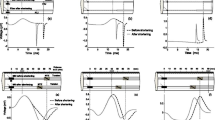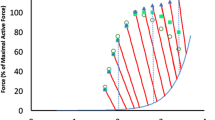Abstract
Interactions between physiological stimulus frequencies, fascicle lengths and velocities were analyzed in feline caudofemoralis (CF), a hindlimb skeletal muscle composed exclusively of fast-twitch fibers. Split ventral roots were stimulated asynchronously to produce smooth contractions at sub-tetanic stimulus frequencies. As described previously, the peak of the sub-tetanic force-length relationship was found to shift to longer lengths with decreases in stimulus frequency, indicating a length dependence for activation that is independent of filament overlap. The sub-tetanic force-velocity (FV) relationship was affected strongly both by stimulus frequency and by length; decreases in either decreased the slope of the FV relationship around isometric. The shapes of the force transients following stretch or shortening revealed that these effects were not due to a change in the instantaneous FV relationship; the relative shape of the force transients following stretch or shortening was independent of stimulus frequency and hardly affected by length. The effects of stimulus frequency and length on the sub-tetanic FV relationship instead appear to be caused by a time delay in the length-dependent changes of activation. In contrast to feline soleus muscle, which is composed exclusively of slow-twitch fibers, CF did not yield at sub-tetanic stimulus frequencies for the range of stretch velocities tested (up to 2 L0/s). The data presented here were used to build a model of muscle that accounted well for all of the effects described. We extended our model to account for slow-twitch muscle by comparing our fast-twitch model with previously published data and then changing the necessary parameters to fit the data. Our slow-twitch model accounts well for all previous findings including that of yielding.
Similar content being viewed by others
References
Ariano MA, Armstrong RB and Edgerton VR (1973) Hindlimb muscle fiber populations of five mammals. J Histochem Cytochem 21: 51–55.
Balnave CD and Allen DG (1996) The effect of muscle length on intracellular calcium and force in single fibres from mouse skeletal muscle. J Physiol 492: 705–713.
Bellemare F, Woods JJ, Johansson R and Bigland-Ritchie BR (1983) Motor-unit discharge rates in maximal voluntary contractions of three human muscles. J Neurophysiol 50: 1380–1392.
Bigland B and Lippold OCJ (1954) Motor unit activity in the voluntary contraction of human muscle. J Physiol 125: 322–335.
Botterman BR, Iwamoto GA and Gonyea WJ (1986) Gradation of isometric tension by different activation rates in motor units of cat flexor carpi radialis muscle. J Neurophysiol 56: 494–506.
Brown IE, Liinamaa TL and Loeb GE (1996a) Relationships between range of motion, Lo and passive force in five strap-like muscles of the feline hindlimb. J Morphol 230: 69–77.
Brown IE, Scott SH and Loeb GE (1996b) Mechanics of feline soleus: II. Design and validation of a mathematical model. J Muscle Res Cell Motil 17: 219–232.
Brown IE, Kim DH and Loeb GE (1998a) The effect of sarcomere length on triad location in intact feline caudofemoralis muscle fibers. J Muscle Res Cell Motil 19: 473–477.
Brown IE, Satoda T, Richmond FJR and Loeb GE (1998b) Feline caudofemoralis muscle. Muscle fiber properties, architecture, and motor innervation. Exp Brain Res 121: 76–91.
Brown IE and Loeb GE (1995) A damaged state in cat caudofemoralis muscle induced by high forces. Can J Physiol Pharmacol 73: Ai(Abstract).
Brown IE and Loeb GE (1998a) A physiological model of the dynamic force-producing properties of mammalian fast-twitch skeletal muscle. Soc Neurosci Abstr 24: 1672 (Abstract).
Brown IE and Loeb GE (1998b) Post-activation potentiation: a clue for simplifying models of muscle dynamics. Am Zool 38: 743–754.
Brown IE and Loeb GE (1999a) A reductionist approach to creating and using neuromusculoskeletal models. In: Winters JM and Crago PE (eds) Biomechanics and Neural Control of Movement Springer-Verlag, New York.
Brown IE and Loeb GE (1999b) Measured and modeled properties of mammalian skeletal muscle. I. The effects of post-activation potentiation on the time-course and velocity dependencies of force production.
Burke RE, Levine DN, Tsairis P and Zajac FE (1973) Physiological types and histochemical profiles in motor units of the cat gastrocnemius. J Physiol 234: 723–748.
Chizeck HJ (1992) Adaptive and nonlinear control methods for neuroprostheses. In: Stein RB, Peckham HP and Popovic D (eds) Neural Prostheses: Replacing Motor Function after Disease or Disability (pp. 298–328). Oxford University Press, New York.
Close RI (1972) The relations between sarcomere length and characteristics of isometric twitch contractions of frog sartorius muscle. J Physiol 220: 745–762.
Cooper S and Eccles JC (1930) The isometric responses of mammalian muscles. J Physiol 69: 377–385.
Cordo PJ and Rymer WZ (1982) Contributions of motor-unit recruitment and rate modulation of compensation for muscle yielding. J Neurophysiol 47: 797–809.
Durfee WK and Palmer KI (1994) Estimation of force-activation, force-length, and force-velocity properties in isolated, electrically stimulated muscle. IEEE Trans Biomed Engng 41: 205–216.
Ford LE, Nakagawa K, Desper J and Seow CY (1991) Effect of osmotic compression on the force-velocity properties of glycerinated rabbit skeletal muscle cells. J Gen Physiol 97: 73–88.
Gribble PL and Ostry DJ (1996) Origins of the power law relation between movement velocity and curvature: modeling the effects of muscle mechanics and limb dynamics. J Neurophysiol 76: 2853–2860.
Hatze H (1977) A myocybernetic control model of skeletal muscle. Biol Cybernet 25: 103–119.
Herzog W, Kamal S and Clarke HD (1992) Myofilament lengths of cat skeletal muscle: theoretical considerations and functional implications. J Biomech 25: 945–948.
Hill AV (1938) The heat of shortening and the dynamic constants of muscle. Proc R Soc Lond (Biol) 126: 136–195.
Hoffer JA, Sugano N, Loeb GE, Marks WB, O'Donovan MJ and Pratt CA (1987) Cat hindlimb motoneurons during locomotion: II. Normal activity patterns. J Neurophysiol 57: 530–553.
Joyce GS, Rack PMH and Westbury DR (1969) Mechanical properties of cat soleus muscle during controlled lengthening and shortening movements. J Physiol 204: 461–474.
Kernell D, Eerbeek O and Verhey BA (1983) Relation between isometric force and stimulus rate in cat's hindlimb motor units of different twitch contraction times. Exp Brain Res 50: 220–227.
Krylow AM and Rymer WZ (1997) Role of intrinsic muscle properties in producing smooth movements. IEEE Trans BME 44: 165–176.
Loeb GE, Brown IE and Cheng EJ (1999) A hierarchical foundation for models of sensorimotor control. Exp Brain Res 126: 1–18.
Malamud JG, Godt RE and Nichols TR (1996) Relationship between short-range stiffness and yielding in type-identified, chemically skinned muscle fibers from the cat triceps surae muscles. J Neurophysiol 76: 2280–2289.
Metzger JM (1995) Myosin binding-induced cooperative activation of the thin filament in cardiac myocytes and skeletal muscle fibers. Biophys J 68: 1430–1442.
Moisescu DG and Thieleczek R (1979) Sarcomere length effects on the Sr2+-and Ca2+-activation curves in skinned frog muscle fibres. Biochim Biophys Acta 546: 64–76.
Moss RL, Swinford A and Greaser ML (1983) Alterations in the Ca2+ sensitivity of tension development by single skeletal muscle fibers at stretched lengths. Biophys J 43: 115–119.
Moss RL (1992) Ca2. regulation of mechanical properties of striated muscle. Mechanistic studies using extraction and replacement of regulatory proteins. [Review]. Circ Res 70: 865–884.
Nichols TR and Houk JC (1976) Improvement in linearity and regulation of stiffness that results from actions of stretch reflex. J Neurophysiol 39: 119–142.
Otten E (1987) A myocybernetic model of the jaw system of the rat. J Neurosci Meth 21: 287–302.
Powers RK and Binder MD (1991) Effects of low-frequency stimulation on the tension-frequency relations of fast-twitch motor units in the cat. J Neurophysiol 66: 905–918.
Press WH, Flannery BP, Teukolsky SA and Vetterling WT (1986) Numerical Recipes. Cambridge University Press, Cambridge, UK.
Rack PMH and Westbury DR (1969) The effects of length and stimulus rate on tension in the isometric cat soleus muscle. J Physiol 204: 443–460.
Roszek B, Baan GC and Huijing PA (1994) Decreasing stimulation frequency-dependent length-force characteristics of rat muscle. J Appl Physiol 77: 2115–2124.
Scott SH, Brown IE and Loeb GE (1996) Mechanics of feline soleus. I. Effect of fascicle length and velocity on force output. J Muscle Res Cell Motil 17: 205–218.
Scott SH and Loeb GE (1995) The mechanical properties of the aponeurosis and tendon of the cat soleus muscle during whole-muscle isometric contractions. J Morphol 224: 73–86.
Stephenson DG and Wendt IR (1984) Length dependence of changes in sarcoplasmic calcium concentration and my ofibrillar calcium sensitivity in striated muscle fibres. J Muscle Res Cell Motil 5: 243–272.
Stephenson DG and Williams DA (1982) Effects of sarcomere length on the force-pCa relation in fast-and slow-twitch skinned muscle fibres from the rat. J Physiol 333: 637–653.
Swartz DR and Moss RL (1992) Influence of a strong-binding myosin analogue on calcium-sensitive mechanical properties of skinned skeletal muscle fibers. J Biol Chem 267: 20497–20506.
Westerbald H, Duty S and Allen DG (1993) Intracellular calcium concentration during low-frequency fatigue in isolated single fibers of mouse skeletal muscle. J Appl Physiol 75: 382–388.
Westerbald H and Allen DG (1991) Changes of myoplasmic calcium concentration during fatigue in single mouse muscle fibers. J Gen Physiol 98: 615–635.
Yang Z, Stull JT, Levine RJC and Sweeney HL (1998) Changes in interfilament spacing mimic the effects of myosin regulatory light chain phosphorylation in rabbit psoas fibers. J Struct Biol 122: 139–148.
Zahalak GI (1981) A distribution-moment approximation for kinetic theories of muscular contraction. Math Biosci 55: 89–114.
Zahalak GI (1986) A comparison of the mechanical behavior of the cat soleus muscle with a distribution-moment model. J Biomech Eng 108: 131–140.
Zajac FE (1989) Muscle and tendon: Properties, models, scaling and application to biomechanics and motor control. Crit Rev Biomed Engng 17: 359–411.
Author information
Authors and Affiliations
Corresponding author
Rights and permissions
About this article
Cite this article
Brown, I.E., Cheng, E.J. & Loeb, G.E. Measured and modeled properties of mammalian skeletal muscle. II. The effectsof stimulus frequency on force-length and force-velocity relationships. J Muscle Res Cell Motil 20, 627–643 (1999). https://doi.org/10.1023/A:1005585030764
Issue Date:
DOI: https://doi.org/10.1023/A:1005585030764




